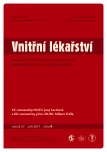Plypharmacy and drug interactions
Authors:
J. Suchopár; M. Prokeš
Authors‘ workplace:
Infopharm, a. s., Praha, předseda představenstva PharmDr. Josef Suchopár
Published in:
Vnitř Lék 2011; 57(9): 755-759
Category:
65th birthday Mudr. Jany Laciné and and 60th birthday Milana Tržila
Overview
The growing consumption of drugs and other numerous factors relates to the increasing incidence of polypharmacy. The proportion of patients currently treated with 5 or more medicines at the elderly population in particular is 30–60% of patients. Repeatedly has been proven the dependence between the number of concomitant drugs and occurrence of adverse effects, patients requiring hospitalization, or incidence of moderate and serious drug interactions. Some works show that it is possible to satisfactorily address the issues of polypharmacy, but it requires great courage and an interdisciplinary approach involving modern information technology.
Key words:
drug consumption – polypharmacy – drug interactions
Sources
1. Smečka V, Kolář J. Lékárenství - Lékárenská činnost výdejní I. 1. vyd. Brno: Professional Publishing 2000.
2. Veehof L, Stewart R, Haaijer-Ruskamp F et al. The development of polypharmacy. A longitudinal study. Fam Pract 2000; 17: 261–267.
3. Kennerfalk A, Ruigómez A, Wallander MA et al. Geriatric drug therapy and health care utilization in the United Kingdom. Ann Pharmacother 2002; 36: 797–803.
4. Viktil KK, Blix HS, Moger TA et al. Polypharmacy as commonly defined is an indicator of limited value in the assessment of drug-related problem. Br J Clin Pharmacol 2006; 63: 187–195.
5. Gurwitz JH. Polypharmacy. A new paradigm for quality drug therapy in the elderly? Arch Intern Med 2004; 164: 1957–1958.
6. Junius-Walker Theile G, Hummers-Pradier E. Prevalence and predictors of polypharmacy among older primary care patients in Germany. Fam Pract 2007; 24: 14–19.
7. Rottlaender D, Scherner M, Schneider T et al. Polypharmacy, compliance and non-prescription medication in patients with cardiovascular disease in Germany. Dtsch Med Wochenschr 2007; 132: 139–144.
8. Legemiddelindustriforeningen. Facts and Figures 2006. Oslo: LMI 2006.
9. ÚZIS ČR. Zdravotnictví jako součást národní ekonomiky 2009. Časové řady vybraných finančních ukazatelů. ÚZIS 2010: 50.
10. Hovstadius B, Hovstadius K, Astrand B et al. Increasing polypharmacy – an individual-based study of the Swedish population 2005–2008. BMC Clin Pharmacol 2010; 10: 16–24.
11. Leendertse AJ, Egberts AC, Stoker LJ et al. HARM Study Group. Frequency of and Risk Factors for Preventable Medication-Related Hospital Admissions in the Netherlands. Arch Intern Med 2008; 168: 1890–1896.
12. Garfinkel D, Zur-Gil S, Ben-Israel J. The war against Polypharmacy: A New Cost-Effective Geriatric-Palliative Approach for Improving Drug Therapy in Disabled Elderly People. Isr Med Assoc J 2007; 9: 430–434.
13. Johnell K, Klarin I. The Relationship between Number of Drugs and Potential Drug-Drug Interactions in the Elderly. A Study of Over 600,000 Elderly Patients from the Swedish Prescribed Drug Register. Drug Saf 2007; 30: 911–918.
14. Fialová D, Topinková E, Gambassi G et al. AdHOC Project Research Group. Potentially Inappropriate Medication Use Among Elderly Home Care Patients in Europe. JAMA 2005; 293: 1348–1358.
15. Topinková E, Mádlová P, Fialová D et al. Nová evidence-based kritéria pro posouzení vhodnosti lékového režimu u seniorů. Kritéria STOPP (Screening Tool of Older Person’s Prescritption) a START (Screening Tool to Alert Doctors to Right Treatment). Vnitř Lék 2008; 54: 1161–1169.
Labels
Diabetology Endocrinology Internal medicineArticle was published in
Internal Medicine

2011 Issue 9
Most read in this issue
- Proteinuria in primary care
- Prokinetic agents – their contribution to practice of gastroenterology
- Plypharmacy and drug interactions
- Thyreopathy in primary care
